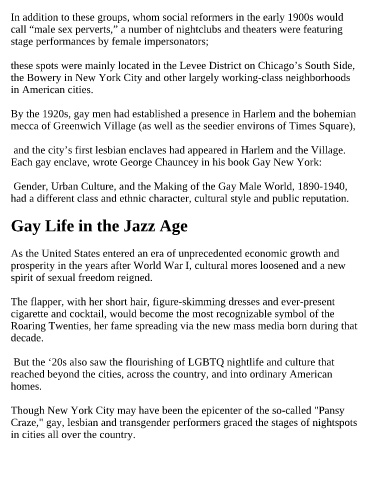Page 456 - ILIAS ATHANASIADIS AKA RO1
P. 456
In addition to these groups, whom social reformers in the early 1900s would
call “male sex perverts,” a number of nightclubs and theaters were featuring
stage performances by female impersonators;
these spots were mainly located in the Levee District on Chicago’s South Side,
the Bowery in New York City and other largely working-class neighborhoods
in American cities.
By the 1920s, gay men had established a presence in Harlem and the bohemian
mecca of Greenwich Village (as well as the seedier environs of Times Square),
and the city’s first lesbian enclaves had appeared in Harlem and the Village.
Each gay enclave, wrote George Chauncey in his book Gay New York:
Gender, Urban Culture, and the Making of the Gay Male World, 1890-1940,
had a different class and ethnic character, cultural style and public reputation.
Gay Life in the Jazz Age
As the United States entered an era of unprecedented economic growth and
prosperity in the years after World War I, cultural mores loosened and a new
spirit of sexual freedom reigned.
The flapper, with her short hair, figure-skimming dresses and ever-present
cigarette and cocktail, would become the most recognizable symbol of the
Roaring Twenties, her fame spreading via the new mass media born during that
decade.
But the ‘20s also saw the flourishing of LGBTQ nightlife and culture that
reached beyond the cities, across the country, and into ordinary American
homes.
Though New York City may have been the epicenter of the so-called "Pansy
Craze," gay, lesbian and transgender performers graced the stages of nightspots
in cities all over the country.

